Latest posts by (see all)
- The Best Things to Do in Tulsa - June 26, 2020
- The Most Interesting Things to Do in Springfield Mo - June 15, 2020
- Best Things to Do in Salt Lake City - May 26, 2020
- 10 Best Websites for Playing Online Games - May 22, 2020
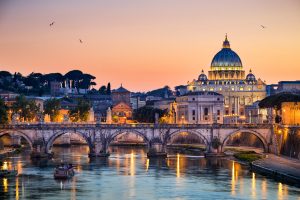 Having arrived on vacation in Italy, be sure to come to Rome first. You can explore the church of St. Peter, wander the ruins of the Colosseum, experience the mystical fear of the Pantheon and throw a coin in the Trevi Fountain. Immerse yourself in the beauty of the evening Rome. You will have the opportunity to watch the twilight change at night, sitting in a small Italian restaurant. Night changes the city. Streets and establishments are becoming more crowded. Feel the special atmosphere of the night city, strolling along the beautiful fountains or one of the many squares.
Having arrived on vacation in Italy, be sure to come to Rome first. You can explore the church of St. Peter, wander the ruins of the Colosseum, experience the mystical fear of the Pantheon and throw a coin in the Trevi Fountain. Immerse yourself in the beauty of the evening Rome. You will have the opportunity to watch the twilight change at night, sitting in a small Italian restaurant. Night changes the city. Streets and establishments are becoming more crowded. Feel the special atmosphere of the night city, strolling along the beautiful fountains or one of the many squares.
Contents
- Thing to do number 1: Go to the Villa Borghese
- Thing to do number 2: Visit the Pantheon
- Thing to do number 3: Go upstairs the Holy Staircase
- Thing to do number 4: Have a walk at the Navona Square
- Thing to do number 5: Go to the Piazza del Popolo
- Thing to do number 6: Look at the Castle of the Holy Angel
- Thing to do number 7: Visit the Roman National Museum
- Thing to do number 8: Go to the Spada Gallery
- Video
Thing to do number 1: Go to the Villa Borghese
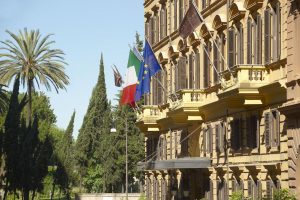 This famous landmark of Rome is located on the hill of Pinch. The great palace of Borghese (Palazzo Borghese), built in the early XVII century, the Romans called the harpsichord (cembalo) for a bizarre shape. The Palace of Borghese was built by Cardinal Camillo Borghese as a family residence. Of great value there is the Borghese Gallery, formed under the Cardinal Scipio Borghese, which holds a unique collection of sculptures and paintings of famous masters.
This famous landmark of Rome is located on the hill of Pinch. The great palace of Borghese (Palazzo Borghese), built in the early XVII century, the Romans called the harpsichord (cembalo) for a bizarre shape. The Palace of Borghese was built by Cardinal Camillo Borghese as a family residence. Of great value there is the Borghese Gallery, formed under the Cardinal Scipio Borghese, which holds a unique collection of sculptures and paintings of famous masters.
In the Borghese Gallery, visitors can see sculptures, reliefs, ancient mosaics, paintings from the 15th – 18th centuries. Among the exhibits there are:
- the sculptural works of Bernini and Canova,
- the canvases by Raphael,
- Titian,
- Botticelli,
- Caravaggio,
- Antonello da Messina,
- Giovanni Bellini,
- Correggio
The complex of Villa Borghese also includes a park founded at Scipio Borghese in the beginning of the XVII century. In the XIX century, most of the park was reconstructed in English style. In the XX century (1903) the park was bought by the state and presented to the city. Today’s park, which is a beautiful example of landscape design, is one of the favorite places for recreation of residents and guests of Rome.
In addition, the Borghese Villa also houses the National Gallery of Modern Art – the famous art museum. It consists of 75 rooms, which store more than 5,000 paintings and sculptures of different eras, as well as a significant collection of Italian paintings of the XIX-XX centuries. This famous landmark of Rome is a favorite place for wedding photosession. It should be noted that the city, like Italy as a whole, has become one of the popular destinations of the so-called “wedding tourism”.
Interesting: Given that the organization of a wedding in Italy is not such a troublesome business (thanks, of course, to the wedding agencies), the great flow of people wishing to make this memorable day even more special.
Thing to do number 2: Visit the Pantheon
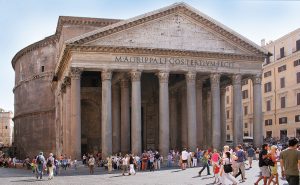 One of the most noteworthy constructions of Rome is the Pantheon – a temple erected in 27 BC. e. Agrippa is the son-in-law of Emperor Augustus. The very first building of the Pantheon, or the Temple of all the gods (from the Greek pan – everything, theos – the gods), was square, round it made under Adrian – in 118-125.
One of the most noteworthy constructions of Rome is the Pantheon – a temple erected in 27 BC. e. Agrippa is the son-in-law of Emperor Augustus. The very first building of the Pantheon, or the Temple of all the gods (from the Greek pan – everything, theos – the gods), was square, round it made under Adrian – in 118-125.
The Pantheon, undoubtedly, was the crowning of the architectural thought of its time. According to the legend, to build a roof over a huge structure, from inside it was gradually filled with soil mixed with gold coins. When the work was completed, the emperor announced that every Roman who found a coin could take it. Instantly inside the church it was empty. However, historians believe that the legend was invented by the architects of the Renaissance, who could not comprehend the secret of building the dome.
In ancient times, the temple worshiped the main Roman gods:
- Jupiter,
- Venus,
- Neptune,
- Mars,
- Mercury,
- Pluto and Saturn.
During the ceremonies, animals were sacrificed. Today, the pagan customs in the temple recalls only the “oculus” – a hole in the dome, which has a diameter of 9 meters, under which in ancient times there was a sacrificial altar. Another legend tells us that initially the structure did not have a hole in the dome, it was struck by the evil spirits of the pagan temple, which were dashed in fear at the sounds of the first mass.
Interesting: The thickness of the walls of the structure is 6 meters, the width of the dome is 43.3 meters: an ideal sphere can be inscribed in the Pantheon’s room.
Thing to do number 3: Go upstairs the Holy Staircase
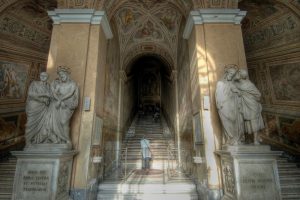 The Holy Staircase, according to the legend, is the same staircase that Jesus Christ ascended to the house of Pontius Pilate. It was taken to Rome from Jerusalem by Helen, the mother of the emperor Constantine the Great. Now the Holy Staircase is a popular attraction of Rome.
The Holy Staircase, according to the legend, is the same staircase that Jesus Christ ascended to the house of Pontius Pilate. It was taken to Rome from Jerusalem by Helen, the mother of the emperor Constantine the Great. Now the Holy Staircase is a popular attraction of Rome.
Some facts from the history that attract visitors:
- When in 1307 a terrible fire destroyed the papal residence in the Lateran Palace, and the popes returned from Avignon to Rome, a new papal palace was decided to be built in the Vatican.
- The place of the former Patriarchate fell into decay, and remained in desolation until the 16th century, until Pope Sixtus V deployed new construction on this site.
- The main chapel of the former Lateran Palace remained untouched. Since it contained the most relics, it was called the Holy of Holies (Sancta Sanctorum).
- Architect Domenico Fontana was commissioned to build a separate building around the Holy Chapel.
The most important treasure of the chapel was considered to be the miraculous icon of Christ, dating from the 6th-7th century. In the structure of the building the Holy Staircase, brought by Elena was organically built. The structure, which contains the Chapel of the Holy of Holies and the Holy Staircase, received the status of a church, and was named the San Lorenzo in Palatio Sancta Sanctorum. This temple is also included in the complex of buildings of the Cathedral of St. John the Baptist.
Christian believers are supposed to overcome 28 steps of the Holy ladder only on their knees, reading prayers and applying themselves to small glazed windows, mounted in those places of the staircase, where, it is believed, the blood of Christ was dripping.
Interesting: For tourists and the public there are two more stairs, decorated with sculptural groups “Kiss of Judas” and “Pilate, showing Christ to the people”.
Thing to do number 4: Have a walk at the Navona Square
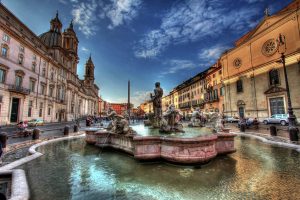 On this square of Rome, the atmosphere of the holiday reigns round the clock – tourists from all over the city flock here. The square has an oval shape, which it owes to an antique stadium built by Guy Julius Caesar, and then rebuilt by Domitian (1st century BC). The ruins of the stadium eventually turned into walls of neighboring houses – ancient stones can be seen from the outside of the square. Until 1869 there was a market on the square, on holidays there were festivities with costumed fights and other competitions (from the Greek – agonas), which finally gave the name of the square.
On this square of Rome, the atmosphere of the holiday reigns round the clock – tourists from all over the city flock here. The square has an oval shape, which it owes to an antique stadium built by Guy Julius Caesar, and then rebuilt by Domitian (1st century BC). The ruins of the stadium eventually turned into walls of neighboring houses – ancient stones can be seen from the outside of the square. Until 1869 there was a market on the square, on holidays there were festivities with costumed fights and other competitions (from the Greek – agonas), which finally gave the name of the square.
Baroque features the square of Navona acquired under the Pope Innocent X, at the behest of which the palace of Pamphili was built here for the wife of the brother of the pope – Olympia, thanks to which he took the papal throne. Next to the Palazzo Pamphili there is the church of Sant’Agnese in Agone, dedicated to Saint Agnes.
The fountain of the Four Rivers of the work of Gian Lorenzo Bernini occupies the central place on Navona Square. It is decorated with sculptural images of the major world rivers:
- the Ganges,
- the Danube,
- the Nile and La Plata.
They symbolize the four continents – Europe, Asia, Africa and America.
It was on Navona Square that the famous confrontation of two respected Roman architects of those times took place: Bernini vs Borromini. “Stumbling blocks” were the two above described buildings – the facade of the Church of Saint Agnes Borromini and the fountain of the Four Rivers Bernini. Borromini allegedly believed that the figures of the river gods of the fountain turned away from his creation – the facade of the church of Saint Agnes, while Bernini thought that the statue of the saint was too lenient to look at the fountain. The confrontation resulted in mutual reproaches and suspicions, and even in sending spies to each other’s workshops. Whether this architectural competition actually took place, or nevertheless there is a certain discrepancy in the dates, historians cannot say with certainty. In any case, tourists rush to the Piazza Navona, to see with their own eyes both the fountain of Bernini and the facade of the church of Borromini.
Interesting: By the way, on the edges of the square there are two more fountains: one of them is the Fountain of the Moor, was created by the Giacomo Porta project, and restored according to the project of Bernini. Another fountain – the fountain of Neptune – originally consisted of only one bath, which at the end of the XIX century, added sculptures.
Thing to do number 5: Go to the Piazza del Popolo
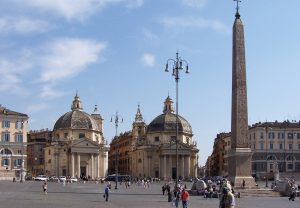
As the legend says, it was at the site of the current Plaza del Popolo that the Roman emperor Nero was buried. The Romans were sure that the unclean power was in the tomb of the late Emperor, and the specter of the damned tyrant at night troubled the surrounding inhabitants. Therefore, Pope Paschal II ordered to throw Neron’s ashes in the river, and in place of the tomb to build a church in honor of the Holy Virgin. So in 1099 the church of Santa Maria del Popolo appeared here. In 1472 the church underwent a reconstruction. Over its reconstruction, the best masters of the Renaissance labored:
- the painters Raphael, Pinturicchio, Carracci:
- the architects Bernini, Bramante and Sansovino.
The main altar of the church is decorated with Raphael’s painting “Madonna del Popolo”. In addition to it, the masterpieces of the great masters are called “The Conversion of Saul” and “The Crucifixion of the Apostle Peter” by Caravaggio, as well as the “Ascension of Our Lady” by Carracci. The Chigi Chapel, located to the left of the entrance to the church, is framed by Raphael’s sketches. He also worked on decorating the dome with a mosaic.
Interesting: In the church you can see the sculptures of the work of Bernini and Lorenzetto – the pupil of Raphael.
Thing to do number 6: Look at the Castle of the Holy Angel
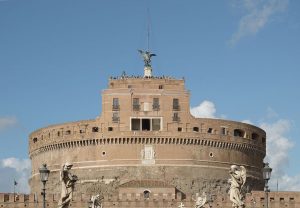 The Castle of the Holy Angel, or the Mausoleum of Hadrian in Rome, was built as a grand royal tomb, which became a fortress only in the Middle Ages. Today, this castle in Rome is a powerful fortress on a square base with four round towers at the corners, which bear the names of the apostles:
The Castle of the Holy Angel, or the Mausoleum of Hadrian in Rome, was built as a grand royal tomb, which became a fortress only in the Middle Ages. Today, this castle in Rome is a powerful fortress on a square base with four round towers at the corners, which bear the names of the apostles:
- Matthew,
- John,
- Mark
- and St. Luke.
The castle kept in its bowels a mausoleum under an earthen hill, the surface of which was planted with cypresses. At the very top there was a statue of Emperor Hadrian in a chariot drawn by four horses. During the Roman Empire, the Pantheon became a military bastion in which the popes sheltered from the invaders, and in peacetime served as a prison. This prison was considered the most impregnable in the whole empire, and only one person managed to escape – the sculptor and adventurer Benvenuto Cellini, who by this escape gained great fame.
The facade of this building is faced with a rare marble, called “moonstone”, and along the perimeter of the structure there are tablets with carved on them names and titles of all those who found rest in the mausoleum. On the roof of the castle of St. Angela there is a viewing platform, over which the Angel is hovering – a statue giving the construction a name. According to legend, it was this Angel who brought the city the news of the soonest disposal of the terrible plague epidemic that occurred during the time of the pontificate of Gregory the Great. By the way, the figure of the Angel on the roof – already the sixth in a row. Previous figures broke lightning or they were removed when there was a shortage of metal for weapons in the city. The custom of shooting from the castle cannon at noon also appeared during the time of Gregory the Great – the tradition remains to this day.
Interesting: Today the National Military Museum and the Museum of Arts are located in the Castle of St. Angela. And the silhouette of the castle of Sant’Angelo is, without a doubt, the most recognizable panorama of Rome.
Thing to do number 7: Visit the Roman National Museum
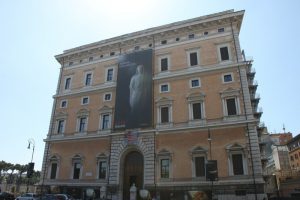 Since 1990, the offices of the Roman National Museum are located in the halls of the Palazzo Altemps. The palace owes its name to the cardinal Marco Sittico Altemps, who came from a very influential family in church circles.
Since 1990, the offices of the Roman National Museum are located in the halls of the Palazzo Altemps. The palace owes its name to the cardinal Marco Sittico Altemps, who came from a very influential family in church circles.
The basis of the museum’s exposition consists of three collections:
- the collection of Cardinal Altemps,
- the collection of the Mattei family
- and the collection of princes Ludovizi-Boncompany, considered the best in the whole Italy.
On the first floor of the museum you can see the Greek statue of Athena Parthenones and a copy of the Greek sculptural group Dionysius. Also in the museum is the throne of Ludovisi – a carved armchair made of marble, a Greek script from the 5th century. BC, decorated with bas-reliefs, illustrating ancient myths, in particular the birth of Aphrodite from the sea foam.
In the Fireplace Hall of the Palazzo Altemps, a marble copy of the bronze original “Galat’s Suicide”, found in the ruins of Caesar’s villa, later turned to Sallust, is presented. It also houses the sarcophagus of Ludovisi (3rd century AD), as well as the giant head of Juno, Goethe’s favorite sculpture.
Interesting: A huge plus of the museum is the presence of spacious bright halls, in which the sculptures are arranged in such a way that they can be viewed from all sides and from a close distance.
Thing to do number 8: Go to the Spada Gallery
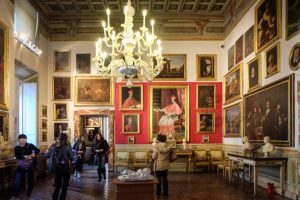 The Spada Gallery is a small Roman museum consisting of 4 halls. It is located in the palace of Cardinal Bernardino Spada (1594 – 1661) – a generous patron and connoisseur of Baroque art. The museum retains the atmosphere that prevailed there under the Cardinal. Works of art stored in the palace are part of the personal collection of Cardinal Bernardino Spada, as well as his great-grandson Cardinal Fabrizio Spada (1643-1717).
The Spada Gallery is a small Roman museum consisting of 4 halls. It is located in the palace of Cardinal Bernardino Spada (1594 – 1661) – a generous patron and connoisseur of Baroque art. The museum retains the atmosphere that prevailed there under the Cardinal. Works of art stored in the palace are part of the personal collection of Cardinal Bernardino Spada, as well as his great-grandson Cardinal Fabrizio Spada (1643-1717).
In the collection there are a lot of paintings by artists from the 16th and 17th centuries, among them there are the works of:
- Guido Reni,
- Portrait of a Musician by Titian,
- Rubens,
- Jan Bruegel the Elder,
- Guercino
- and Artemisia Gentileski.
Of the sculptures located in the gallery, the most famous is the ancient statue of Pompey, found during excavations in the environs of Campo de Fieri. For a long time it was believed that Julius Caesar was stabbed at its foot. Another notable attraction of the museum is the Borromini Gallery in the left part of the yard. Borromini, fond of optical perspective, built a gallery that seemed quite long – 40 meters at first glance, at the end of which stands a large winged statue. In fact, the length of the gallery is not large – only 8.82 meters, and the statue is very small in size.
The master achieved this effect by lowering the ceiling towards the end of the gallery, and simultaneously raising the floor. The palace was designed and built by the architect Bartolomeo Baronino in 1550 for Cardinal Jrolamo Capodiferro (1502-1559), who decided to erect it on the site of the buildings belonging to his family.
Interesting: The modern gallery of Spada opened in 1927. At the same time, the State Council was located in the Palace of the Spade.